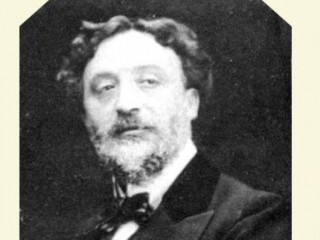
Hector Guimard biography
Date of birth : 1867-03-10
Date of death : 1942-05-20
Birthplace : Lyon, France
Nationality : French
Category : Arhitecture and Engineering
Last modified : 2012-01-19
Credited as : architect, French Art Nouveau style,
0 votes so far
Guimard's critical reputation has risen since the 1960s, as many art historians have praised his architectural and decorative work, the best of it done during a relatively brief fifteen years of prolific creative activity.
The Castel Béranger made Guimard famous and he soon had many commissions. He continued working in the Art Nouveau style, especially devoted to its ideal of harmony and continuity, which caused him to design the interior decoration of his buildings as well. This culminated during 1909 with the Hotel Guimard (his wedding present to his rich American wife) where ovoid rooms contain unique pieces of furniture, which are considered integral parts of the building.
If the skylights favored by Victor Horta are rather absent in his work (except in his 1910 Mezzara Hotel), Guimard made noteworthy experiments in space and volume. Some of these include the Coilliot house and its disconcerting double-frontage (1898), La Bluette and its beautiful volumetric harmony (1898), and especially the Castel Henriette (1899) and the Castel d’Orgeval (1905), radical demonstrations of a vigorous and asymmetrical "free plan", twenty-five years before the theories of Le Corbusier. But other buildings of his, like the splendid Nozal Hotel, (1905), employ a rational, symmetrical, square-based style like that of Viollet-le-Duc.
Guimard also employed some structural innovations, as in the extraordinary concert hall Humbert-de-Romans (1901), where a complex frame divides sound waves resulting in perfect acoustics, or as in the Hôtel Guimard (1909), where the ground was too narrow to have the exterior walls bear any weight, and thus the arrangement of interior spaces differ from one floor to another.
The curious, inventive Guimard was also a precursor of industrial standardization, insofar as he wished to diffuse the new art on a large scale. His greatest success here – in spite of some scandals – was his famous entrances to the Paris Metro, based on the ornamented structures of Viollet-le-Duc. The idea is taken up – but with less success – in 1907 with a catalogue of cast iron elements applicable to buildings : Artistic Cast Iron, Guimard Style.
Guimard's art objects have the same formal continuity as his buildings, harmoniously uniting practical function with linear design, as in the Vase des Binelles, of 1903) or this sketch of his furniture.
His inimitable stylistic vocabulary suggests plants and organic matter, while remaining abstract. Flexible mouldings and a sense of movement are found in stone as well as wood carvings. Guimard created abstract two-dimensional patterns that were used for stained glass (Mezzara hotel, 1910), ceramic panels (Coilliot house, 1898), wrought iron (Castel Henriette, 1899), wallpaper (Castel Béranger, 1898) or fabric(Guimard hotel, 1909).
Despite of Guimard's innovations and talent, the press soon tired of him—not so much with his work, but his personality. His relationship with the clergyman who commissioned him to build the Humbert de Romans Concert Hall (arguably the most complete expression of his Art Nouveau style) became acrimonious by the time of its completion in 1901, and the clergyman left France. Within five years the magnificent concert venue was demolished; it is now only known by photographs and articles from art journals. A large number of his Paris Métro station entrances, including all of the large pavilions such as the one at Bastille, were demolished. The only full, roofed enclosures left are the original one at Porte Dauphine and the reconstructed ones at Abbesses and Châtelet, although many of the fenced entrances remain or have been rebuilt.
Guimard's work is itself victim of inherent contradictions of the ideals of the Art Nouveau style: his best creations remained unaffordable to the general public, and his attempts at standardization of materials, parts, and measures never could keep pace with his stylistic changes. Guimard's fear of war and the Nazi Party's anti-Semitism (his wife was Jewish) forced him into exile, and he was largely forgotten when he died in New York during 1942.
Many of Guimard's buildings were destroyed after his death, but he started to be rediscovered during the 1960s. Now, scholars have reconstructed his career and he has been the subject of much research. Still, one hundred years after what Le Corbusier termed the "magnificent gesture" of Art Nouveau, most of Guimard's buildings remain inaccessible to the public, and he has no museum devoted to him. However, original architectural drawings by Guimard are stored in the Dept. of Drawings & Archives at Avery Architectural and Fine Arts Library at Columbia University in New York City.
















